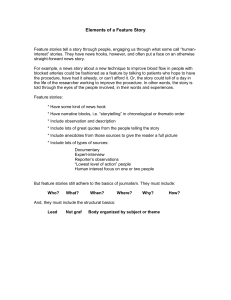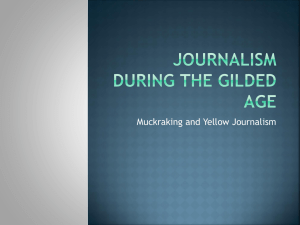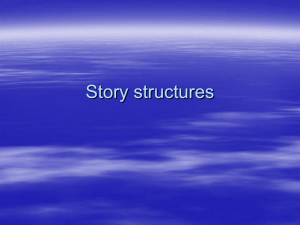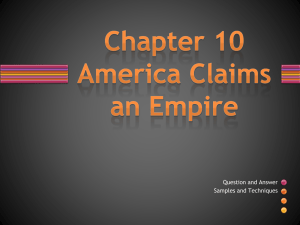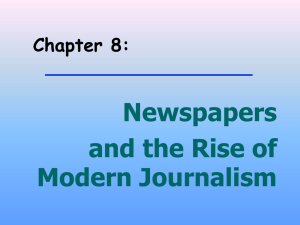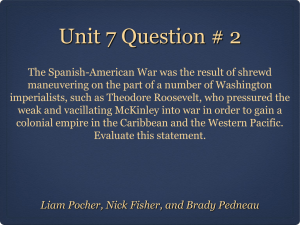Week-2-Tufts - Maria Burns Ortiz
advertisement
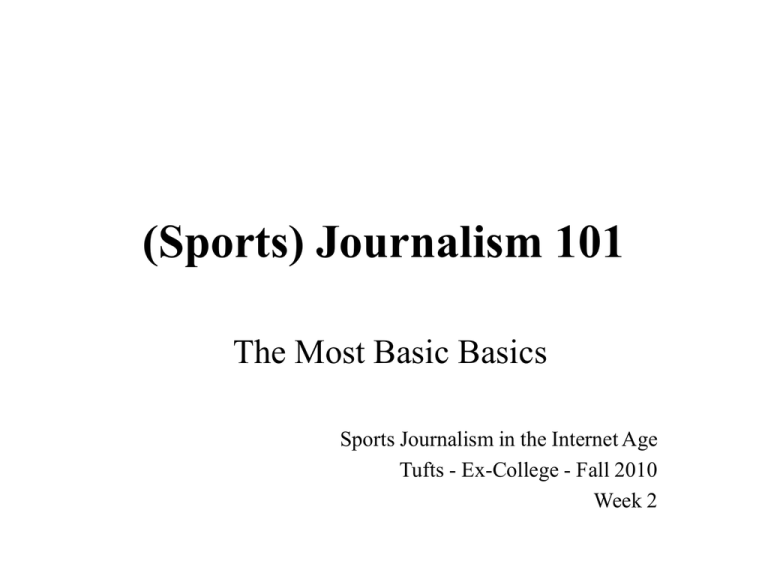
(Sports) Journalism 101 The Most Basic Basics Sports Journalism in the Internet Age Tufts - Ex-College - Fall 2010 Week 2 Journalism Basics • Journalistic writing differs from academic writing. • In journalism, it is not about using a lot of big words and flowery language to impress people. Journalism should be easy to read and follow. • Longer does not automatically equal better. • Most newspapers are written at a high-school reading level. Grade Level and Circulat ion of Current Periodicals Grade Periodical Circulatio n Level Los Angeles Times 12 1,292,274 Boston Globe 12 707,813 National Enquirer 12 2,760,000 New Yorker 10 1,900,000 New York Times 10 1,680,583 Washington Post 10 1,007,487 USA Today 10 2,665,815 TV Guide 9 13,200,000 Time 9 4,114,137 Reader's Digest 9 12,212,040 Source: Impact Information, 2005. Terminology • Lede – the introduction of a story. The first few grafs. This is what sets a story up and pulls readers in. Sometimes, written “lead.” • Graf – paragraph. • Nut graf – the graf or grafs that sum up what the purpose of the story is. Why it’s being told. What the information the writer is trying to convey. • Copy – the written text of a story. Types of Ledes • Hard lede – Straightforward. Gets to the information in right away. Often referred to as AP lede because almost all AP stories have hard ledes. • Anecdotal lede – Sets the piece up with a short story. • Scene-setter – Sets the scene. • Question lede – Opens by posing/asking a question. Types of Ledes to Avoid • Quote lede – Opens with a quote. • Buried lede – when the engaging part of a story, the part the writer probably should have started with, is further down in the piece, or “buried” in the article. Types of Stories • Hard news stories – breaking news of the day. Very timely. Not a lot of room for creativity. No opinion. This is often the standard news story you would expect to see on the front page. • Game/event stories. • Features – less time-sensitive than hard news stories. Can be tied to an event in terms of timeliness or can be completely timeless. • Columns – Opinion pieces. Some Journalism Basics • Do not miss deadline. Ever. Ever. EVER. • Always check spelling of names, teams, places, etc. Then check them again. • With the invention of spell check, there’s no excuse for having words spelled wrong. • Never trust your memory for facts. Confirm that information. Double-check stats. Some Journalism Basics • Clean copy will make you an editor’s favorite writer. • Do not use three words when one will do. – Closer Dave Simms was able to put the game away. – Closer Dave Simms put the game away. – Bennett pitched seven innings of shutout ball. – Bennett pitched seven shutout innings. Some Journalism Basics • Some things will be obvious by context. – The Spartans beat the Trojans 3-0 in the game on Wednesday night. – The Spartans beat the Trojans 3-0 on Wednesday night. – Sea City pitcher Phil Bennett struck out four Tucson batters. – Sea City pitcher Phil Bennett struck out four. Some Journalism Basics • When quoting, try to put the speaker’s name before said. PREFERRED: “The offensive line played a great game,” quarterback Peyton Manning said. AVOID: “The offensive line played a great game,” said quarterback Peyton Manning. • Use full name on first reference. Then last name throughout. Some Journalism Basics • Structure news stories with essential information high (early) in the story. – For example, in a game story, the score should always be in the first graf, if not the first sentence. • Inverted pyramid – a way of structuring a story so the most important information is at the top and information gets progressively less central to the story. AP Style • Comes from the Associated Press Stylebook and Briefing on Media Law. • Style and usage guide used by newspapers and in the news industry in the United States. It is the basis for virtually every news publication’s style – when to capitalize, use numerals, preferred spellings and abbreviation. • Some papers/sites have their own additional style guides. But the basis for those is going to be AP. AP Style • Considered the Bible of journalism. The industry standard. • If you have any interest in becoming a journalist, buy and learn the AP Stylebook. AP Style 101 (The Sports Reporter’s Version) Numbers • Spell out one through nine. Use numerals for numbers 10 and up. Number Exceptions • Games in a series – (Game 1, Game 2, Game 3) • Numbers with decimal points – 4.2 points per game, 2.45 ERA • Football yardage – Brady threw a 5-yard pass. – Bush rushed for 3 yards. Number Exceptions • Made vs. Attempted – Paul Pierce was 3-of-6 at the free throw line. – Joe Mauer went 2-for-5 against Cleveland. • Records – The Raiders fell to 0-8 on the season. – After going 3-0 in July, Johan Santana went 2-4 in August. Number Exceptions • Scores and series records are always numbers. – – – – Spain beat the Netherlands 1-0. The Saints beat the Vikings 14-9. The Lakers lead the season series with the Celtics 3-2. Toronto FC sits in third place in the Eastern Conference standings with a 7-9-7 record. – Novak Djokovic defeated Roger Federer 5-7, 6-1, 5-7, 6-2, 7-5 in the US Open semifinal. Other Style and Usage Notes • Alternate city and team names in a story. • Give team name and city on first reference. – The Boston Celtics signed Shaquille O’Neal in August. • Spell out positions. – Shortstop (not SS). Running back (not RB). Grammar Basics Common Grammar Mistakes • Use a hyphen when a figure is used as an modifier. – Brees threw a 5-yard pass. (modifying pass) – Brees threw for 5 yards. (giving a distance) – Ramirez hit a 420-foot home run. – Ramirez home run went for 420 feet. Plural vs. Singular • Cities are singular. – New York leads the AL East. – Many feel Miami is the team to beat in the NBA. • Teams are plural. – The Yankees lead the AL East. – Many feel the Heat are the team to be in the NBA. Note: Even when a team has a singular name – Jazz, Avalanche, etc. – it is used as a plural noun. Plural vs. Singular • Differentiate between its and their. – Cincinnati headed back to its locker room at the half, trailing 7-0. – The Bengals headed back to their locker room at the half, trailing 7-0. • A team is an its. A club is an its. CORRECT: Is a team responsible for the behavior of its players? INCORRECT: Is a team responsible for the behavior of their players? Other Common Mistakes • its (possessive) • it’s (it is) • their (possessive) • there (location) • they’re (they are) One Word vs. Two Words Noun: One Word, Verb: Two Noun shutout strikeout Verb shut out strike out, struck out knockout knock out lineup line up playoff play off kickoff kick off Commonly Misspelled Words One Word Two Words ballpark home run ballgame free throw fastball ball carrier doubleheader double play quarterback running back (When in doubt, do a Google search to see what AP uses.)
